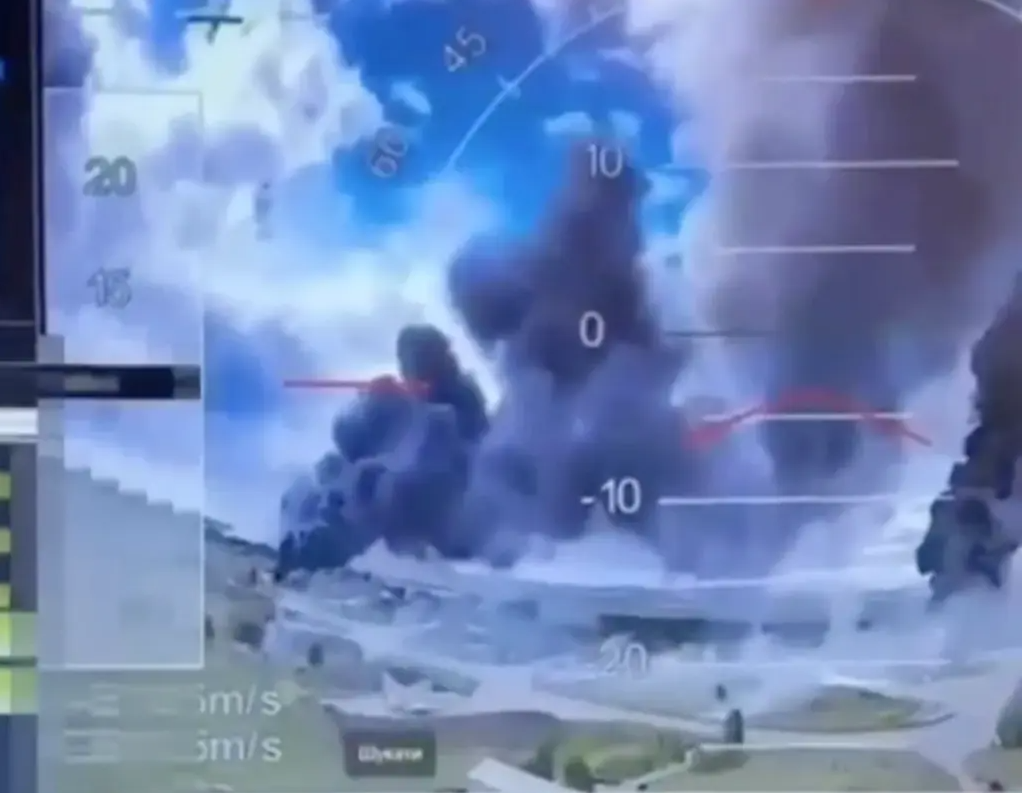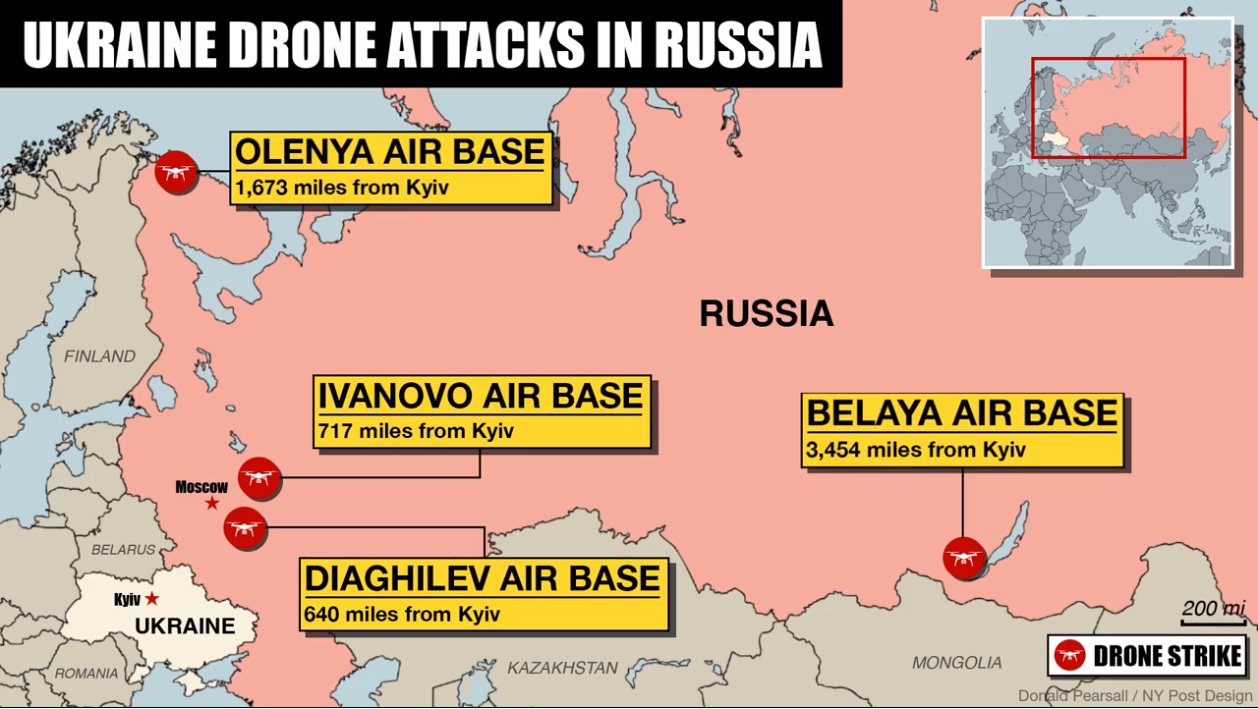Three major diplomatic challenges have driven a wedge between the United States and Russia in their peace negotiations. Their divergence highlights more than a clash between worldviews. It shows their competition for leadership in the reconstruction of the international order.

A screenshot from a drone video of the alleged attack released by the SBU on June 1, 2025. Footage showed Ukraine’s daring drone strike on the Kremlin’s aircraft deep in Russian territory. (Photo: Ukraine's Security Service)
On May 19, U.S. President Donald Trump had a phone call with Russia’s Vladimir Putin that lasted more than two hours. Despite Trump’s high expectations for the conversation, it yielded no substantial breakthroughs.
As costs of the war in Ukraine continue to mount, U.S.-Russia peace negotiations have grown more complex because of the diverging demands of the parties. Trump remains convinced that the time is right for negotiations and that a cease-fire is possible. Therefore, just three weeks into his term, he spoke with Putin by phone. Although Russia and Ukraine had engaged in technical negotiations in Saudi Arabia as a gesture of goodwill toward Washington, the discussions avoided core issues. Trump then proposed a tentative cease-fire plan in April that included recognition of Russian-controlled Crimea and informal recognition of Russia’s control over most of the Ukrainian territory it occupied after 2022.
This was rejected by Ukraine. The Istanbul negotiations on May 16 were also fruitless. Considering the positions of all sides, even if Russia and Ukraine were to agree to a cease-fire, Washington and Moscow would still need to adjust their diplomatic strategies to find a breakthrough.

Ukraine recently wipes out dozens of Russian doomsday nuclear bombers in massive surprise attack on air bases. The attack came just a day before the leaders of Ukraine and Russia were potentially set to meet in Istanbul as part of US-backed cease-fire talks.
Three diplomatic challenges
Prospects for peace negotiations are closely related to the state of the U.S.-Russia relationship. Their interactions over the past five months have revealed three major diplomatic challenges that have directly contributed to their lack of agreement.
• First, tactical diplomacy and strategic deadlock. In the negotiations, Trump seeks a quick agreement, viewing compromise as part of the process. Putin has pursued “strategic depth” and has taken a tough stance aimed at resolving the root causes of the conflict. Trump’s tactical approach is often seen by Putin as a demand for unilateral concessions to the West. In Moscow, this mismatch of goals has reduced the credibility of the U.S. peace initiative, and the Russians prefer to procrastinate.
• Second, undermined personal interaction and sidelined multilateral frameworks. Trump believes that Russia’s centralized power structure means that agreements made directly with Putin can efficiently bypass bureaucratic red tape and multilateral mechanisms. However, unilateral interactions that ignore NATO allies has not only eroded transatlantic trust but also increased Russia’s array of bargaining chips. In contrast, although Putin also promotes diplomatic interactions between heads of state, he is more adept at exploiting the decentralized global power structure, building counterweights to the West and addressing crises through the Global South and the Islamic world.
• Third, the constraints of “America first.” An ardent advocate of the “America first” doctrine, Trump favors limited engagement in overseas affairs and shows no interest in long-term commitments. This isolationism constrains his Russia policy, reducing the strategic flexibility of the United States in global power competition. Putin regards the Ukraine war as a strategic confrontation with the West and prefers to invest in long-term efforts to reshape Russia’s status as a great power. Obviously, Trump’s diplomatic style has created opportunities for Putin, allowing him to gradually set the pace and parameters of peace negotiations.
Adjusting gaming strategies
Although these diplomatic challenges have hindered the progress of peace negotiations, the spillover effects of the war have prompted both sides to adjust their strategies. By seeking breakthroughs in inevitable compromises, they try to maximize their interests in future negotiations.
Trump needs to reshape the strategic cooperation of Europe and the United States. In addressing the Ukraine issue, pragmatism remains the most viable approach for transatlantic leaders. Focusing on their long-term security interests, European countries continue to show willingness to cooperate with Trump by increasing defense spending, increasing military aid to Ukraine and harnessing the influence of the Pope and the United Kingdom to mediate the conflict.
The Trump administration met with some European leaders in the White House, and its national security team also discussed the Ukraine issue with European partners through various channels. German Chancellor Friedrich Merz has also adjusted his campaign-era stance of alienating the United States and has actively engaged with Trump in an effort to rebuild the transatlantic relationship. For European leaders, the stakes are clear: If they wish to avoid a future as neighbors to a fully militarized Russia, any future European security framework must include strategic cooperation with the United States.
Putin may be open to resolving the war in phases. Since the start of peace negotiations, he has insisted on bundling his demands — such as recognition of his territorial claims, restrictions on NATO’s eastward expansion and sanctions relief — as a prerequisite for any cease-fire or peace deal. In order to consolidate his relationship with Trump, however, Putin may soften his stance and accept a step-by-step approach.
This year, Russia’s defense spending is projected to reach $156 billion, or about 33 percent of its federal budget. To sustain this huge level of spending, the government has slashed social security spending by 16 from 2024. Obviously, phased concessions in the peace negotiations are a two-birds-with-one-stone strategy for Russia. It may mitigate domestic social conflicts while also allowing Moscow to preserve its wartime gains and negotiating leverage. In addition, it helps maintain the fragile U.S.-Russia relationship and increase the sense of war fatigue among Ukraine’s allies.
Inevitable structural conflicts
At present, the trend toward international political fragmentation is prominent, which largely reflects the inherent structural tensions in the international system, as exemplified by the relationship between the United States and Russia. These tensions manifest primarily in two ways:
First, their strategic goals are fundamentally at odds. In the name of “America first,” Trump promotes shifts in the international order to safeguard U.S. strategic interests. On the other hand, Putin believes that his “special military operation” is a Russian imperative, arguing that the international order needs to change and that a new order must eliminate the root causes of the crisis and ensure Russia’s national security.
Second is a strategic clash of logic. The United States seeks to enforce a “peace through strength” idea, while Russia emphasizes the need to build multipolar checks and balances and strategic buffer zones. This inherent difference in views on strength makes it difficult to mitigate the structural tensions between the two sides. Russia views the demilitarization of its buffer zone as a prerequisite for achieving peace and demands recognition as an equal power in its relations with the West. By contrast, Washington continues to treat Russia as a persistent threat.
Going ahead, the rivalry between the United States and Russia in Ukraine peace negotiations will continue to collide. Their different worldviews are shaped by different historical experiences, philosophies and political values, but also by competition for leadership in the reconstruction of the international order.
